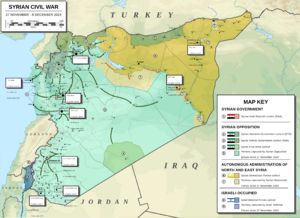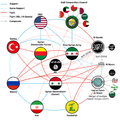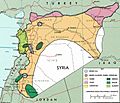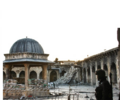Syrian civil war facts for kids
The Syrian Civil War was a long and complicated conflict in Syria. It started in March 2011 when many people were unhappy with the government led by Bashar al-Assad. They held large protests and rallies across Syria, asking for more freedom and democracy. This was part of a bigger movement in the region called the Arab Spring.
After months of the government trying to stop the protests, different rebel groups like the Free Syrian Army started to form. This was the beginning of an armed fight. By mid-2012, this fight had grown into a full-scale civil war.
Rebel forces got weapons from countries like Saudi Arabia and Turkey, and some Western countries. They first made good progress against the government, which was getting help from Iran and Russia. The rebels even took control of cities like Raqqa in 2013 and Idlib in 2015. Because of this, Iran sent military help to the Syrian government in 2014, and Russia joined in 2015. This changed the war's direction. By late 2018, most rebel areas, except parts of the Idlib region, were taken back by government forces.
In 2014, a group called the Islamic State (also known as ISIS) won many battles against both the rebels and the Syrian government. They took control of large parts of Eastern Syria and Western Iraq. This led the U.S. and its allies to form a group called CJTF. They started bombing ISIS from the air and giving support to the Kurdish-led Syrian Democratic Forces on the ground. ISIS was mostly defeated by late 2017 after big battles in Raqqa and Deir ez-Zor.
In August 2016, Turkey started its own military actions in northern Syria. They did this because a Kurdish-led area called Rojava was created. Turkey also fought ISIS and later government forces. Between a ceasefire in March 2020 and late 2024, the main fighting stopped, but there were still small fights.
Heavy fighting started again in November 2024 with a big rebel attack in the northwest. This attack was led by a group called Tahrir al-Sham and supported by other groups. They captured Aleppo, Hama, and Homs. Rebels in the south, who had previously made peace with the government, then launched their own attack, taking Daraa and Suwayda. Other groups, like the Syrian Free Army and the Syrian Democratic Forces, also started their own attacks in Palmyra and Deir ez-Zor. By December 8, the rebel forces had taken the capital city, Damascus. After this, the Assad government collapsed, and Bashar al-Assad fled to Moscow. On the same day, Israel launched an invasion into Syria's Quneitra Governorate, aiming to take control of a UN buffer zone in the Golan Heights.
Contents
How the Syrian Civil War Began
The Start of the Protests (2011)
In March 2011, many people in Syria were unhappy with President Bashar al-Assad's government. This led to large protests and rallies across the country, asking for more democracy. These protests were part of the bigger Arab Spring movement happening in other countries in the region.
The government's security forces tried to stop these protests using violence. Many people were killed or arrested, including many regular citizens. The Syrian revolution then changed into an armed uprising as different groups started to fight back. By 2012, this had grown into a full civil war.
A Time of Less Fighting (2020–2024)
After a ceasefire in March 2020, the main fighting between the Syrian government and opposition groups mostly stopped. By 2021, the Assad government controlled about two-thirds of the country and was trying to become stronger.
Even though the main fighting had calmed down, there were still small clashes in northwestern Syria. Also, large protests started in southern Syria and spread across the country. People were protesting against the government's strict rules and the bad economic situation. These protests reminded many people of the 2011 revolution that started the civil war. By early 2023, the war had largely settled into a stalemate, meaning neither side was making big gains.
Rebels Attack Again and the Government Falls (2024)
On November 27, 2024, a group of opposition forces, led by Hay'at Tahrir al-Sham, launched a major attack against the Syrian Army and other pro-government groups. This happened in the areas of Aleppo, Idlib, Hama, and Homs Governorate.
Soon after, other rebel groups from the south and east also started taking over government land. On November 29, rebel forces entered Aleppo as the Syrian Army's positions collapsed across the country. On December 7, rebel forces entered Damascus, the capital city. The next day, December 8, Bashar al-Assad was reported to have left the capital.
The Syrian Army confirmed that Assad was no longer in power and had fled the country. This led to the collapse of his government, ending over 60 years of rule by the Assad family. Assad and his family went to Moscow and were given a safe place to stay in Russia. The Syrian Prime Minister, Mohammad Ghazi al-Jalali, said he would work with any new leaders chosen by the people.
A group called the Syrian Salvation Government set up a temporary government in Damascus. Mohammed al-Bashir became the prime minister during this change. Ahmed al-Sharaa, the leader of the Syrian Salvation Government, became the main leader of Syria.
On December 8, 2024, Israel invaded southern Syria. They took control of the Golan Heights buffer zone and captured Quneitra, a Syrian town near Mount Hermon. Israel also launched air attacks against former Syrian military bases, air defense systems, and weapon storage sites. This was done to destroy Assad's old military equipment.
Images for kids
-
Esther Brimmer (US) speaks at a United Nations Human Rights Council urgent debate on Syria, February 2012
See also
 In Spanish: Guerra civil siria para niños
In Spanish: Guerra civil siria para niños



















